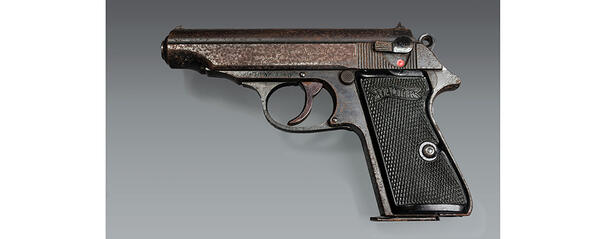The name Walther PP is derived from the surname of Franz Walther, head of the German weapons company, and the German phrase ‘Polizei Pistole’, which translates as ‘police pistol’.
The pistol was created as a civilian and police weapon, but in terms of its technical characteristics it was as close to a military model as possible. The 7.65-millimeter caliber weapon was developed in 1929 based on previous models.
The old German gun-making company Walther had technically advanced equipment and skilled personnel at its disposal, and its products were of high quality.
The success of the new model was determined by its design. The pistol was designed to be as compact and simple as possible and easy to handle. The double-action hammer blowback action allows for firing both with the hammer cocked and released. It fires from open bolt, so the pistol could be fired immediately. The pistol could be safely carried with a round in the chamber. The trigger guard was fitted with cocking and safety features. The pistol also had good accuracy.
Some of the design features were not new. For example, an interchangeable box magazine with a side button latch had previously been used in Hugo Borchardt’s pistol, and a return spring attached to the barrel was patented by John Browning in 1897. However, only Walther PP designers combined all these parts in one pistol and added an improved self-loading mechanism and many original solutions.
During World War II, the new weapon was adopted by senior officers, staff officers, rear units of the Luftwaffe and the Wehrmacht, SS troops, and higher ranks of the Third Reich.
After the war the equipment was exported from the factories of the victorious countries, and in the 1950s the company was revived in Germany. The production of the Walther was resumed in Germany only in the early 1970s. Copies of this gun were produced in Hungary, Romania, Turkey and China.
The pistol was created as a civilian and police weapon, but in terms of its technical characteristics it was as close to a military model as possible. The 7.65-millimeter caliber weapon was developed in 1929 based on previous models.
The old German gun-making company Walther had technically advanced equipment and skilled personnel at its disposal, and its products were of high quality.
The success of the new model was determined by its design. The pistol was designed to be as compact and simple as possible and easy to handle. The double-action hammer blowback action allows for firing both with the hammer cocked and released. It fires from open bolt, so the pistol could be fired immediately. The pistol could be safely carried with a round in the chamber. The trigger guard was fitted with cocking and safety features. The pistol also had good accuracy.
Some of the design features were not new. For example, an interchangeable box magazine with a side button latch had previously been used in Hugo Borchardt’s pistol, and a return spring attached to the barrel was patented by John Browning in 1897. However, only Walther PP designers combined all these parts in one pistol and added an improved self-loading mechanism and many original solutions.
During World War II, the new weapon was adopted by senior officers, staff officers, rear units of the Luftwaffe and the Wehrmacht, SS troops, and higher ranks of the Third Reich.
After the war the equipment was exported from the factories of the victorious countries, and in the 1950s the company was revived in Germany. The production of the Walther was resumed in Germany only in the early 1970s. Copies of this gun were produced in Hungary, Romania, Turkey and China.



